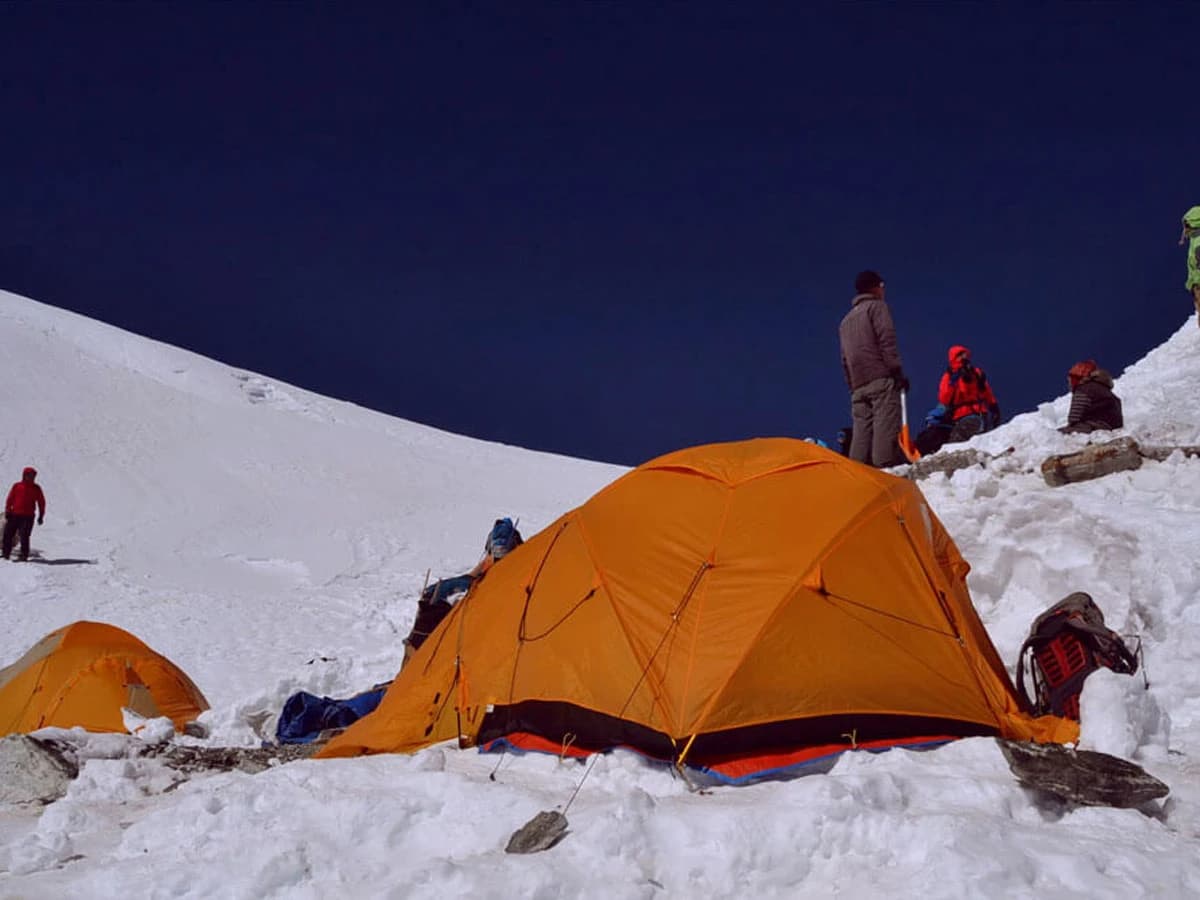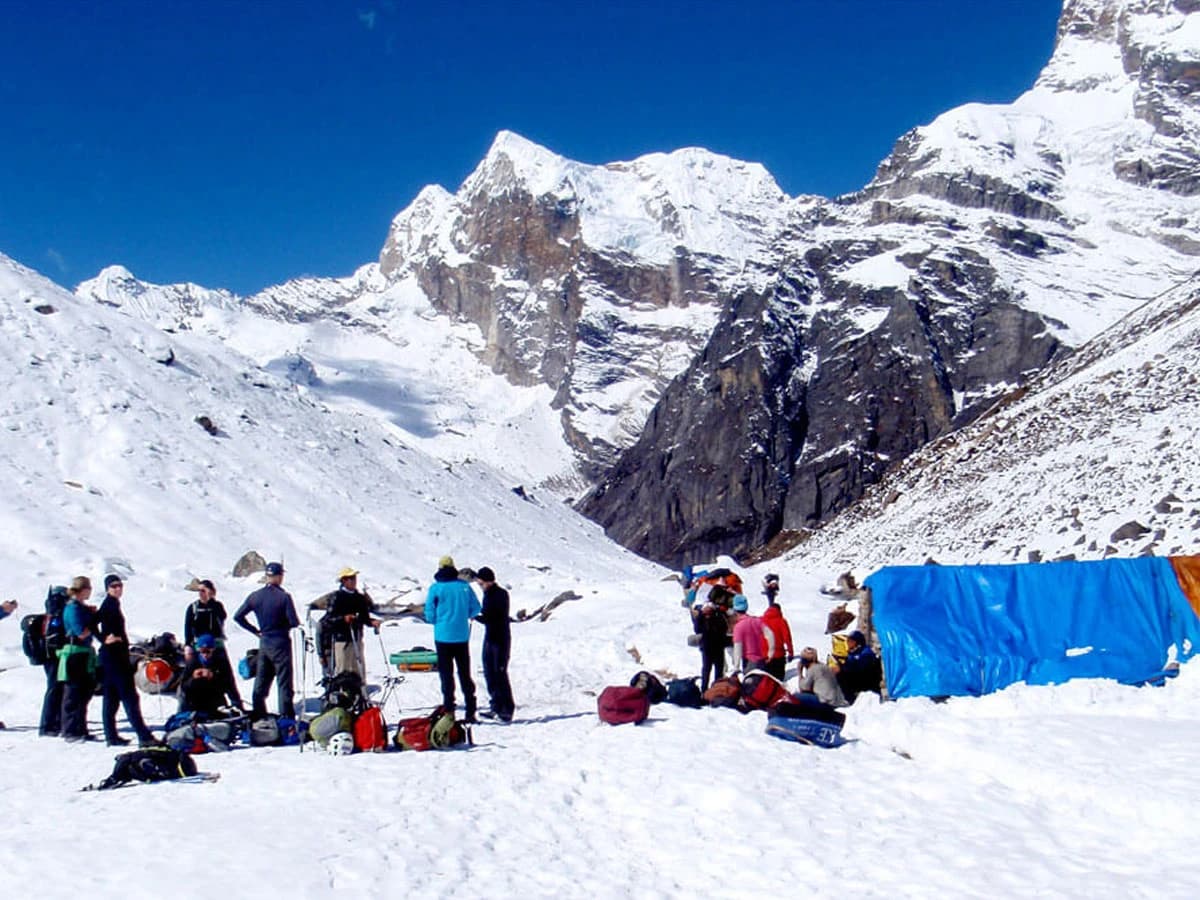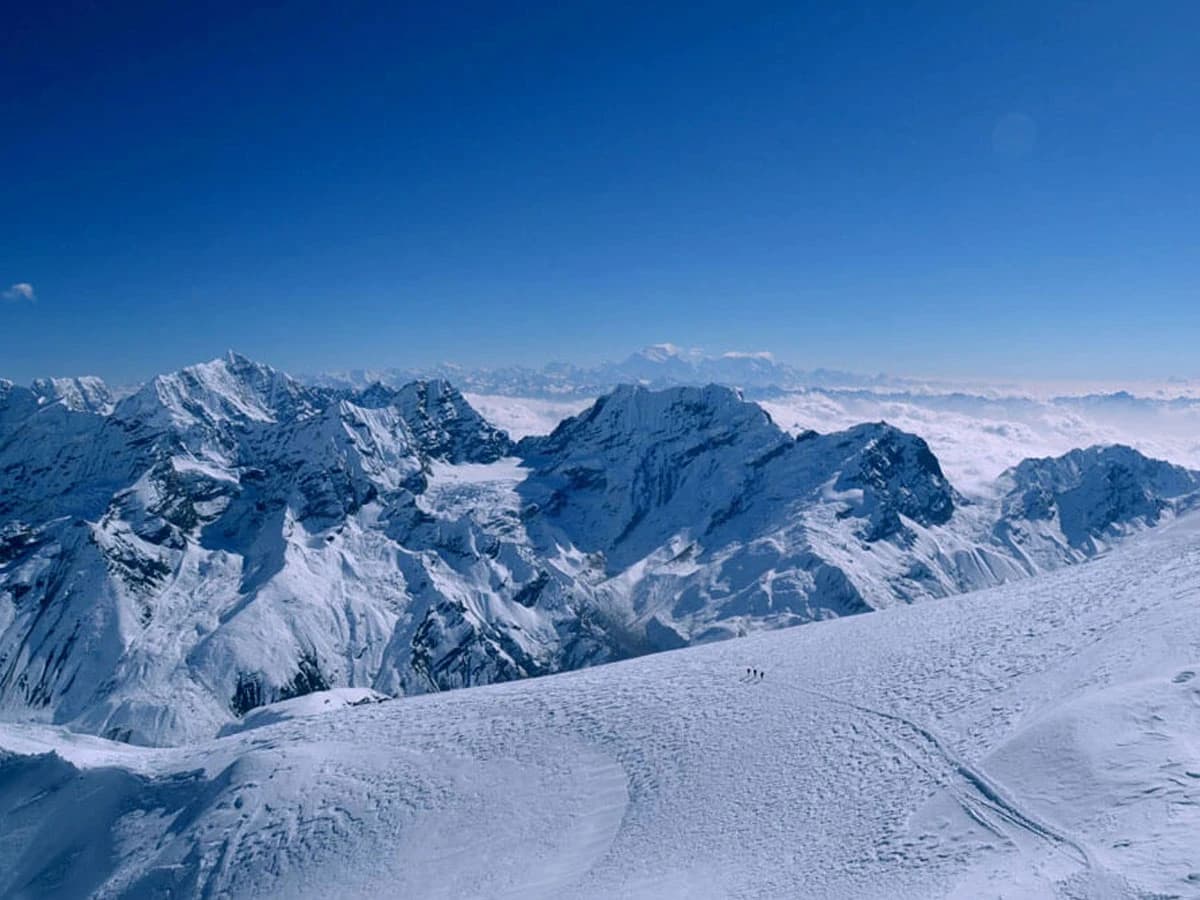Mera Peak Climbing (6,476m/21,247ft) stands out as Nepal’s highest trekking peak, offering a less technical yet physically demanding ascent that rewards climbers with one of the most expansive panoramic views in the Himalayas, including Everest, Lhotse, Makalu, Cho Oyu, and Kanchenjunga. You will traverse the remote Hinku Valley, pass through pristine alpine landscapes, and acclimatize in high-altitude wilderness. The final ascent to the summit is both challenging and exhilarating, culminating in a breathtaking view of the world’s highest peaks, making every step of the journey truly unforgettable.
Mera Peak Climbing
Mera Peak Climbing is an exhilarating 18-day adventure that takes you deep into the heart of the Himalayas, offering an unmatched blend of trekking, high-altitude mountaineering, and breathtaking landscapes. From the very first steps in the remote Hinku Valley to the victorious ascent of Mera Peak (6,476m), every moment is infused with awe, challenge, and exhilaration.
The journey begins with a thrilling flight to Lukla, followed by an immersive trek through lush rhododendron forests, high alpine meadows, and glacial moraines. Trekkers will pass through remote Sherpa villages, experiencing the warmth of local hospitality, and gradually acclimatizing as they ascend towards the higher altitudes.
The trail offers a perfect balance of adventure and serenity, with towering peaks like Everest, Lhotse, Makalu, and Kanchenjunga gracing the horizon at every turn. On Day 9, as trekkers move from Thaknak to Khare, they face the magnificent Mera Glacier, one of the most striking features of the trek.
Stretching endlessly across the towering Himalayas, this colossal ice formation tumbles down the slopes of Mera Peak, sculpting a mesmerizing landscape of gleaming ice walls and dramatic crevasses. The glacier’s immense scale and breathtaking beauty leave trekkers in awe, offering a glimpse into the raw power of the mountains.
At Khare (5,045m), trekkers spend a day acclimatizing and training (Day 10), learning crucial mountaineering techniques for navigating glacial terrain.
As you reach Mera Base Camp and High Camp, the landscape transforms into a world of ice and snow, intensifying the sense of adventure. The final push to the summit is both physically demanding and immensely rewarding, as climbers navigate through pristine glaciers under the guidance of expert mountaineers.
On day 12 reaching the summit is an indescribable moment—standing at the highest trekking peak in Nepal, embraced by a 360-degree panorama of Everest, Lhotse, Cho Oyu, Makalu, and Kanchenjunga, fills you with a sense of accomplishment that lingers long after the descent.
This Mera Trekking Peak Climbing expedition is not just about reaching the top; it’s about immersing yourself in the raw beauty of the Himalayas, testing your limits, and creating memories that last a lifetime.
Whether you are an aspiring mountaineer or a seasoned trekker, Mera Peak Climbing is an invitation to challenge yourself, embrace the unknown, and experience the ultimate thrill of high-altitude adventure.
Highlights
- Trek to Lukla, the gateway to the Everest region, with a thrilling flight that offers stunning aerial views of the Himalayas.
- Experience the rich culture and traditions of the Sherpa people as you pass through remote villages like Chhutok, Kothe, Khare, and Thuli Kharka.
- Enjoy panoramic views of towering peaks such as Everest, Makalu, Lhotse, Cho Oyu, Kanchenjunga, and Mera Peak itself.
- Venture through the UNESCO World Heritage-listed Sagarmatha National Park, where lush forests, alpine meadows, and diverse wildlife await.
- Summit Mera Peak, at 6,476 meters (21,247 feet), is one of Nepal’s highest trekking peaks, and it reveals a sense of accomplishment from reaching its summit.
- Challenge yourself with high-altitude trekking and mountaineering, including glacier crossings and ice climbing, for an adventurous and rewarding experience.
- Benefit from well-placed acclimatization days in Khare and Mera High Camp, which help your body adjust to the altitude and increase your chances of reaching the summit.
- Traverse the stunning glacial terrain, where the views of surrounding snow-capped peaks will leave you in awe.
- Witness unforgettable sunrises and sunsets over the Himalayas, when the peaks are bathed in golden light, offering perfect photo opportunities.
- Feel a sense of personal achievement as you summit Mera Peak, one of the most sought-after trekking peaks in Nepal.
- Stay in cozy teahouses along the way, where you can rest, enjoy hearty meals, and connect with fellow trekkers.
- Experience the peace and isolation of trekking in remote wilderness, far from the crowds, with pristine landscapes and serene surroundings.
Mera Peak Climbing Itinerary
Upon your arrival at Tribhuvan International Airport, a representative from Himalayan Massif Trek will greet you and transfer you to your hotel in Kathmandu. After check-in, take some time to relax and recover from your journey.
Depending on your arrival time, you can explore the vibrant streets of Thamel, visit nearby cultural landmarks, or enjoy a traditional Nepali meal. In the evening, your guide will brief you about the upcoming adventure, ensuring you are well-prepared for the journey ahead.
After a refreshing breakfast, attend a detailed trip orientation where your guide will provide essential information about the journey ahead. You'll receive insights into the trekking route, expected weather conditions, necessary gear, and safety guidelines.
An early morning flight takes you to Lukla, the gateway to the Everest region, offering breathtaking aerial views of the Himalayas.
Upon landing, you will meet your trekking crew and begin your trek. The trail leads through charming villages, dense rhododendron forests, and scenic landscapes.
You will pass through the small settlement of Surke before ascending towards the Chutok La pass. After a few hours of trekking, you will reach Paiya (Chutok), a peaceful village surrounded by lush greenery. Settle into your teahouse, enjoy a warm meal, and rest for the night, preparing for the journey ahead.
Day four of the Mera Peak Climbing Package you will embark on a scenic trek from Paiya to Panggom. The trail meanders through picturesque forests, rolling hills, and traditional Sherpa villages, offering stunning views of the surrounding landscapes.
As you ascend, you will pass through the vibrant vegetation and cross several small streams. The path leads to Panggom, a serene village perched at a higher altitude, offering panoramic views of the surrounding mountains.
After reaching Panggom, settle into your teahouse and enjoy a well-deserved rest while soaking in the tranquil atmosphere of the area.
Today, your trek takes you from Panggom to Ningsow, a journey that will lead you through lush forests, scenic valleys, and charming Sherpa villages. The trail ascends gradually as you pass through beautiful landscapes, offering stunning views of the surrounding hills.
Upon reaching Ningsow, a peaceful village nestled in the heart of the mountains, you will have time to relax and take in the tranquility of the surroundings. Enjoy a warm meal and rest for the night, preparing for the next leg of your adventure.
Today's trek takes you from Ningsow to Chhatra Khola, a beautiful village located at a higher altitude. The trail ascends steadily through dense forests, terraced fields, and small rivers, offering stunning views of the surrounding peaks.
As you progress, you enter the remote and untouched Hinku Valley, a significant milestone in the journey. This valley is known for its rugged landscapes, isolated wilderness, and towering mountain backdrops, setting the stage for the high-altitude adventure ahead.
The transition into Hinku Valley marks the beginning of a more immersive Himalayan trekking experience, far from the busier trails of the Khumbu region. After a fulfilling day of trekking, enjoy a warm meal and settle in for the night, with the majestic mountains looming in the distance.
Today's trek takes you from Chhatra Khola to Kothe, a beautiful village situated at a higher altitude. Leaving the river behind, you follow the Hinku River upstream, trekking through lush rhododendrons and bamboo forests that gradually give way to rugged, alpine landscapes.
A major highlight of today’s journey is your first close-up view of Mera Peak. Seeing this towering giant up close is an exhilarating moment, reminding you of the adventure that lies ahead.
Upon reaching Kothe, a peaceful mountain village nestled in a breathtaking setting, you can relax and soak in the grandeur of the Himalayas. The evening here is quiet and serene, allowing you to truly appreciate the remoteness of your surroundings.
Today's Hike Mera Peak takes you from Kothe to Thaknak, a stunning alpine village located at a higher altitude. As you leave Kothe, the trail winds through rugged terrain, crossing several streams and rivers while offering breathtaking views of the surrounding peaks.
The ascent is steady, and the landscape gradually becomes more barren and mountainous. As you approach Thaknak, you will notice the dramatic change in scenery with its expansive views of glaciers and snow-capped mountains.
After reaching Thaknak, settle into your teahouse, relax, and enjoy the quiet beauty of this high-altitude village.
Today’s trek from Thaknak to Khare is a challenging but rewarding journey as you gain significant altitude. The trail ascends through rocky terrain, with stunning views of surrounding glaciers and towering peaks.
As you move higher, the air becomes thinner, making a slow and steady pace essential for acclimatization. The final stretch involves a steep climb, leading to Khare, the base camp for Mera Peak.
Upon arrival, you will be greeted with breathtaking views of Mera Glacier and the surrounding Himalayas. Spend the rest of the day resting and acclimatizing, preparing for the next phase of your adventure.
Today is a crucial acclimatization day in Khare to help your body adjust to the high altitude before ascending further. You will have plenty of time to rest and explore the surroundings while soaking in breathtaking views of the Himalayas.
As part of your preparation for Mera Peak, your climbing guide will conduct a pre-training session. This includes familiarization with essential climbing gear such as crampons, ice axes, harnesses, and ropes. You will also learn basic mountaineering techniques, including how to ascend and descend on icy slopes safely. This training ensures you are well-prepared for the challenging ascent ahead.
After the session, you can take short hikes around Khare for additional acclimatization or simply relax and conserve energy for the upcoming climb.
Today's trek takes you from Khare to Mera High Camp, bringing you closer to the long-awaited summit push. The journey, part of the Mera Peak Climbing from Khare itinerary, ascends steeply over glacial terrain, requiring careful footing as you navigate icy slopes.
As you climb higher, the air becomes thinner, making slow and steady progress essential. The breathtaking views of Everest, Makalu, Cho Oyu, and other towering peaks make the effort worthwhile.
Upon reaching Mera High Camp, you'll settle into your tented accommodation, surrounded by an awe-inspiring panorama of snow-covered mountains. After a warm meal, you will rest early, conserving energy for the challenging summit climb ahead.
Today is the most exhilarating and challenging day of your journey as you push for the Mera Peak summit. The climb begins before dawn, using headlamps to navigate the icy slopes under the guidance of experienced climbing leaders. The ascent requires steady pacing and endurance, with breathtaking views of Everest, Lhotse, Makalu, Cho Oyu, and Kanchenjunga rewarding your efforts.
Upon reaching the summit at 6,476 meters, you will stand atop one of Nepal’s highest trekking peaks, surrounded by the majestic Himalayas. After taking in the spectacular panorama and capturing the moment, you will begin your descent back to Mera High Camp for a brief rest before continuing down to Khare.
Back in Khare, you will celebrate your achievements, enjoy a warm meal, and rest after this unforgettable adventure.
This extra day is built into the itinerary as a contingency in case of unforeseen circumstances such as bad weather, altitude-related issues, or any delays during the summit push. If everything goes as planned and you have already reached the summit, you can use this day to rest and recover in Khare or explore the surrounding areas.
If the summit attempt was delayed due to weather conditions, this reserve day provides another opportunity to reach the peak under safer conditions. Flexibility is key in high-altitude expeditions, ensuring a successful and safe journey.
After successfully summiting Mera Peak, you will begin your descent from Khare to Kothe. The journey downhill is much easier, allowing you to enjoy the breathtaking scenery at a more relaxed pace. The trail retraces your steps through glacial moraines, rocky paths, and alpine terrain before descending into greener landscapes.
As part of the Mera Trekking Peak Climbing adventure, this descent offers a chance to reflect on your incredible achievement while immersing yourself in the changing landscapes. As you lose altitude, you will feel the oxygen levels increase, making the trek more comfortable.
Upon reaching Kothe, you can celebrate your success with a hearty meal and a well-earned rest in a cozy teahouse, surrounded by the peaceful beauty of the Himalayas.
Today's trek takes you from Kothe to Thuli Kharka, ascending through lush forests of rhododendron and pine. The trail gradually gains elevation as you make your way toward the high alpine terrain. Along the way, you will pass through remote yak pastures and enjoy stunning views of Mera Peak and the surrounding Himalayan range.
As you reach Thuli Kharka, a beautiful open meadow surrounded by rolling hills, you will settle into your teahouse for the night. The crisp mountain air and panoramic scenery provide the perfect setting to relax and reflect on your journey so far.
Your final day of trekking takes you from Thuli Kharka back to Lukla, marking the completion of your incredible journey. The trail begins with an ascent to Zatrwa La Pass (4,600 m), the last major climb of the trek, offering breathtaking views of the Everest, Makalu, and Lhotse ranges.
From the pass, you will begin a long descent through rugged terrain, eventually reaching the lush green hills and forests surrounding Lukla.
Upon arrival in Lukla, you can celebrate your achievement with your trekking team, enjoy a warm meal, and reflect on the unforgettable adventure you have completed. A well-deserved rest awaits before your flight back to Kathmandu the next day.
After an unforgettable journey in the Himalayas, you will take an early morning flight from Lukla back to Kathmandu. The short yet scenic flight offers one last glimpse of the majestic mountains before landing in the bustling capital.
Upon arrival in Kathmandu, you will be transferred to your hotel, where you can relax and unwind. You may choose to explore the city, indulge in a well-deserved celebratory meal, or simply rest after your adventure.
This marks the end of your incredible Mera Peak expedition, leaving you with lifelong memories of the breathtaking landscapes and achievements along the way.
On the final day of your journey, enjoy a leisurely breakfast and some free time to explore Kathmandu one last time.
You may wish to visit local markets, shop for souvenirs, or take a tour of some iconic landmarks like Boudhanath Stupa or Pashupatinath Temple. This is also a great opportunity to reflect on the amazing experiences and connections made during the trek.
Mera Peak Climbing Route Map
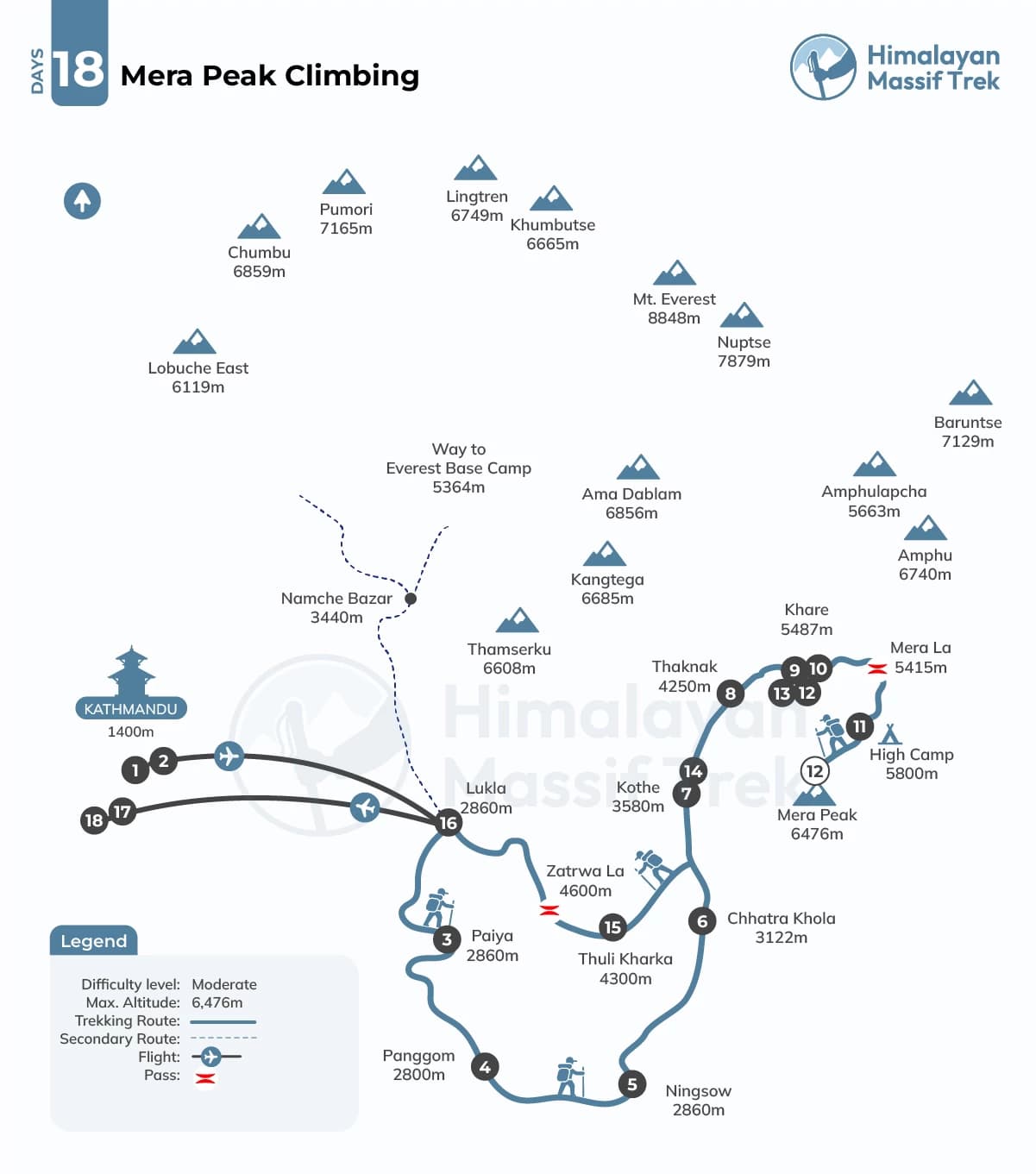

Cost Details
Transport and flights:
- Airport pick up and drop
- All ground and domestic air transfers for the trip
- Domestic flight to Lukla and return to Kathmandu ( Flights will operate from Ramcehhap during April, May, October and November)
Accommodation:
- 3-Star Accommodation in Kathmandu for 3 nights
- Teahouse Accommodation during the trek to Khare
- Tented camps accommodation during the climbing after Khare
Meals:
- 3-Standard meals each day
- Set of Breakfast, Lunch, and Dinner
Permit:
- Climbing permits, trekking permits, National park permits
Guide and porters:
- Certified and qualified English-speaking trekking/
- climbing guide (with a supporting crew of assistants and porters)
- One porter between two climbers
Equipment:
- Duffel Bag, Down Jacket, Sleeping Bag, Tent, Ropes and Harness
- First Aid kit
Miscellaneous:
- Compensation, meals, accommodation, and insurance for the guide and supporting crew
- Communication equipment, and medical evacuation coordination
- 24-hour administrative and online support to monitor the trip conditions, prepare for emergencies, and contact insurance companies
- Nepal Visa Fee
- International Airfare
- Lunch and Dinner in Kathmandu
- Rescue & travel insurance, trip cancellation costs, accident or health emergency, evacuation, loss, theft, or damage to baggage
- Extra night accommodation in Kathmandu due to any reason
- Personal expenses (phone calls, internet, laundry, bar bills, battery recharge, extra porters, cold drinks, bottled or boiled water, hot shower, etc.)
- All alcoholic and non-alcoholic beverages
- Tipping for Guides and Porters
- Personal clothing and other climbing gear not mentioned in the includes section
To confirm your payment, a deposit payment is required, which is 30% of the total booking price. This deposit helps us secure permits, logistics, and other necessary arrangements for your trek.
We understand that plans can change, and we strive to be as flexible as possible. However, to cover operational costs, a cancellation fee applies. This is a percentage of your total booking price and is deducted from the deposit payment.
Cancellation Fees
Cancel 30% days before departure: 5% of the trip cost
Cancel between 10 to 30 days before departure: 10% of the trip cost
Cancel within 10 days of departure: 20% of the trip cost
If you need to cancel, please notify us as early as possible to reduce charges.
Rescheduling
Unexpected circumstances can disrupt travel plans, even if you still want to do the trip. To support our clients, we have generously waived all rescheduling fees. You can postpone and reschedule your trip at no additional cost, as long as the new departure date falls within one year of your original booking.
Upgrades
If you wish to upgrade your accommodation, transportation, or any other services not mentioned in the Trip Includes section, please be aware that these upgrades will incur additional costs. We can assist in arranging these options for you based on your preferences and availability.
Lukla Flights
Non-Refundable Flight Ticket: If you need helicopter evacuation or other means of transport due to altitude sickness or any other condition, your return flight ticket fare is non-refundable.
Refundable Flight Ticket: If the flight operator cancels your flight due to bad weather in Lukla, Kathmandu, or any other reason, your flight ticket fare is 100% refundable.
Dates & Availability
Private TripIf you don't find an appropriate date, you can propose a Preferred Departure Date, and we’ll ensure the trip runs as scheduled just for you.
Trip Gallery
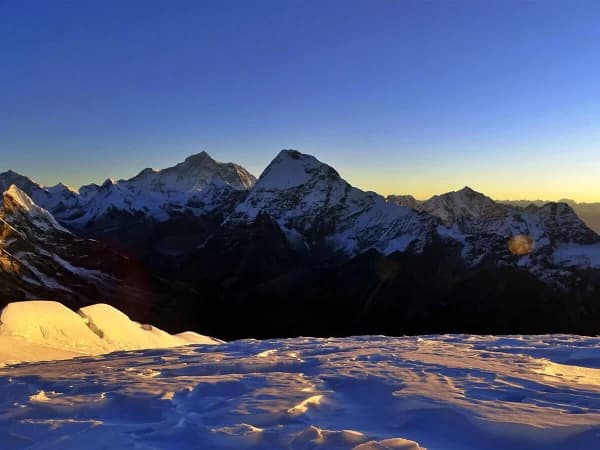
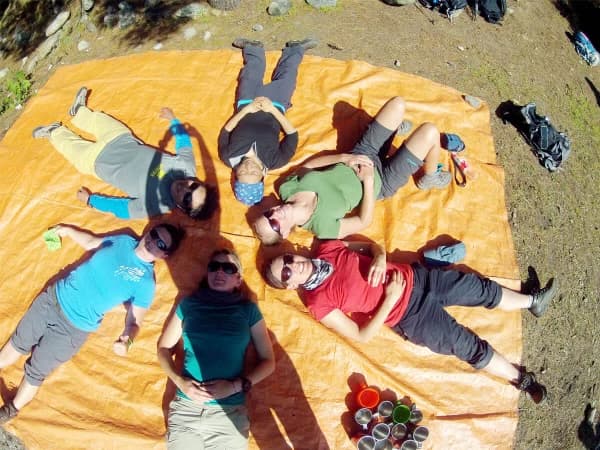
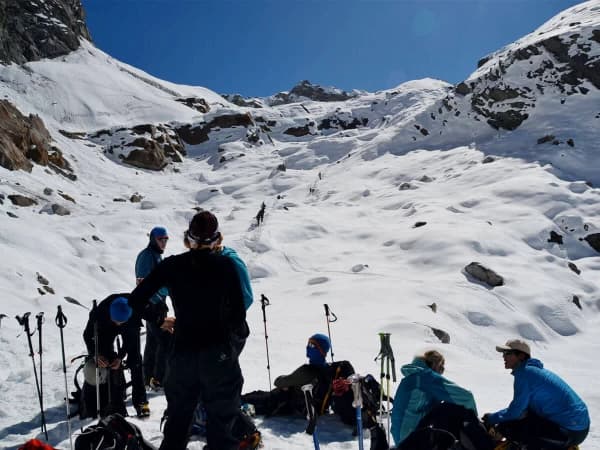
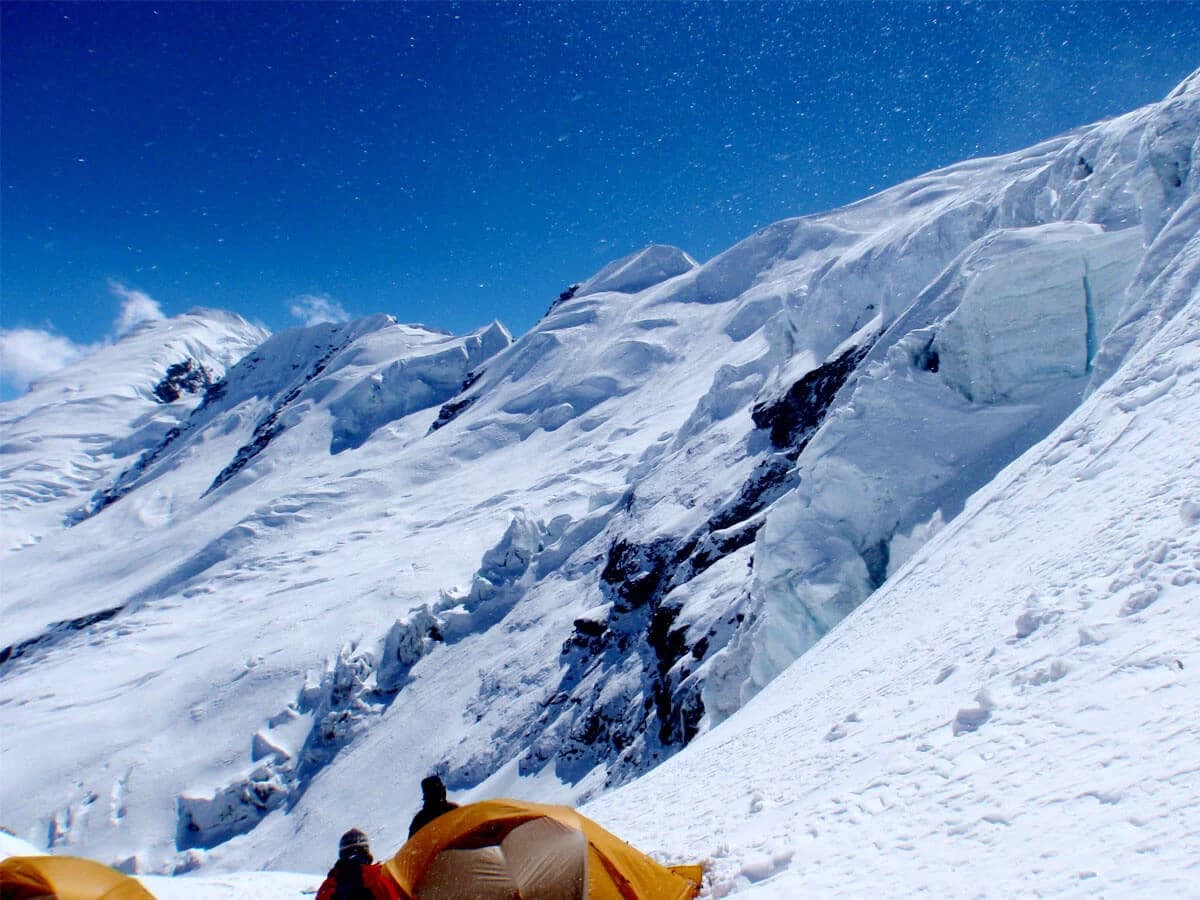

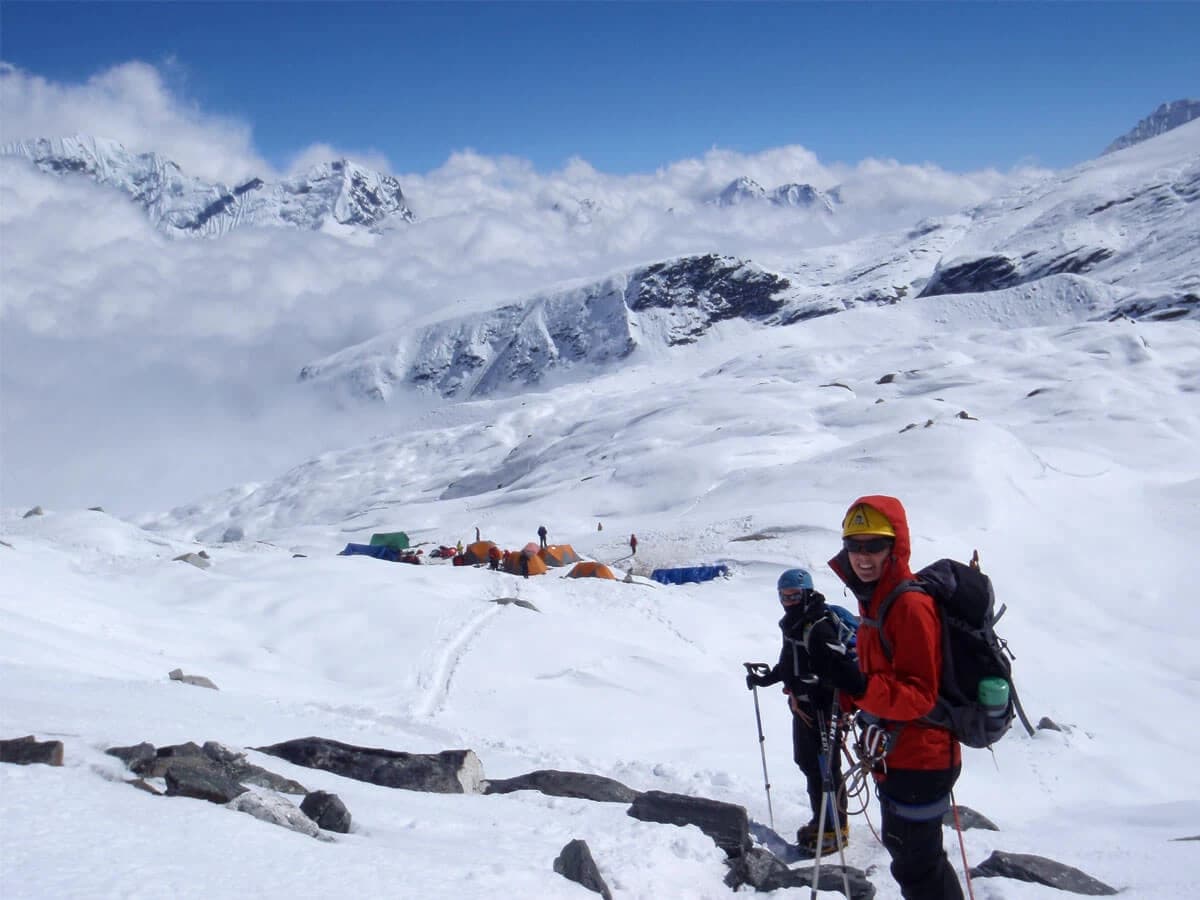
Essential Information
Mera Peak Climbing Permits and Fees
Climbing Mera Peak in Nepal requires specific permits to ensure the safety of trekkers and compliance with local regulations. The fees for these permits can vary depending on the peak's grade and season.
Here’s a breakdown of the necessary permits and their associated fees for Mera Peak Climbing:
Trekking Permit (Sagarmatha National Park Permit)
Fee: Approximately NPR 3,000-3,500 (for foreign nationals)
This permit is mandatory for entry into the Sagarmatha National Park, home to Mera Peak and other iconic peaks, including Mount Everest. The permit can be obtained in Kathmandu or at the Monjo checkpoint, which is the official park entrance.
Mera Peak Climbing Permit
Mera Peak is classified as a trekking peak, making it more accessible compared to higher technical mountains. The fees for this permit are structured based on the season, reflecting the demand and difficulty of the climb:
For individuals:
- NPR 15,000 (from March to May, peak season)
- NPR 10,000 (from September to November, post-monsoon season)
- NPR 7,000 (from December to February, off-season)
What to bring
- Two passport-sized photographs for each permit
- One photocopy of your passport for each permit
- Completed forms for each permit
- Enough Nepali currency to cover the permit costs
These fees are essential for obtaining permission to summit Mera Peak, and they fluctuate according to the trekking season, which influences the climbers’ safety and comfort during the expedition.
Local Community Fees (if applicable)
Depending on the region, additional community fees may be required in areas surrounding the Khumbu region. These fees are used for the maintenance of local infrastructure and the support of community projects. Fees range from NPR 200 to NPR 1,000, depending on the area.
TIMS Card (Trekkers' Information Management System)
Fee: NPR 1,000 (for individual trekkers) or NPR 500 (for group trekkers)
The TIMS card is mandatory for all trekkers in Nepal. This system ensures trekkers' safety by keeping track of their movements throughout their journey. It can be obtained via a registered trekking agency in Kathmandu or Pokhara.
These permits and fees are generally managed and arranged by Himalayan Massif Trek, which handles all necessary documentation before your climb, ensuring everything is in place for a seamless and enjoyable adventure.
Altitude Sickness for Mera Peak Climbing: Precautions, Challenges, and Coping Strategies
Altitude sickness, also known as Acute Mountain Sickness (AMS), occurs when the body struggles to adapt to reduced oxygen levels at high elevations. The symptoms typically start above 2,500m and worsen as altitude increases.
Common symptoms include headache, nausea, dizziness, fatigue, shortness of breath, loss of appetite, and difficulty sleeping. If ignored, AMS can progress to more severe conditions like High Altitude Pulmonary Edema (HAPE) or High Altitude Cerebral Edema (HACE), both of which are life-threatening.
Challenges Climbers May Face
Climbers on Mera Peak may encounter several challenges. One of the primary issues is rapid ascent, where gaining altitude too quickly without proper acclimatization increases the risk of AMS. Harsh weather conditions, including cold temperatures, strong winds, and snowstorms, further add to the difficulty.
At elevations above 6,000m, oxygen levels are significantly reduced, making breathing more difficult and leading to physical exhaustion. Additionally, the remote location of Mera Peak means limited medical facilities and evacuation challenges, making altitude sickness even more dangerous.
How to Prevent and Manage Altitude Sickness
- Gradual Acclimatization: Follow the “climb high, sleep low” principle and allow 2-3 acclimatization days during the trek to help the body adjust to higher elevations.
- Stay Hydrated: Drink at least 4-5 liters of water per day while avoiding alcohol and caffeine, which contribute to dehydration.
- Proper Nutrition: Eat high-carb meals to maintain energy levels, and consume soups, garlic, and ginger tea to aid in acclimatization.
- Medication: Diamox (Acetazolamide) can help prevent AMS, but consult a doctor before use. Carry pain relievers for headaches as well.
- Recognize Symptoms Early: Do not ignore signs of AMS. If symptoms worsen, descend immediately.
- Controlled Breathing and Pacing: Take deep, slow breaths and pace yourself while trekking to avoid overexertion.
Essential Items to Carry for Mera Peak Climbing
- Clothing and Protection: Layered thermal wear, a down jacket, a waterproof shell, gloves, and gaiters to provide warmth and protection from extreme weather.
- Footwear: High-altitude climbing boots with crampons to ensure grip and stability on icy terrain.
- Sleeping Gear: A high-quality sleeping bag rated for -20°C or lower for cold nights at high camps.
- Medical Kit: A well-stocked first-aid kit including AMS medication, painkillers, rehydration salts, and bandages.
- Emergency Equipment: Oxygen cylinders or a portable altitude chamber for emergencies.
- Trekking Gear: Trekking poles for balance and to reduce strain on the knees.
- Navigation Tools: GPS devices, maps, and a compass for proper route guidance.
How These Precautions Make the Trek Easier
Taking these precautions significantly improves the overall trekking experience. Gradual acclimatization ensures that climbers maintain their strength and reduce the chances of AMS, making the trek more comfortable.
Proper hydration and nutrition sustain energy levels, allowing climbers to stay physically strong throughout the journey. Medications and early symptom recognition provide peace of mind, enabling climbers to act swiftly if issues arise.
Carrying essential gear ensures protection against extreme weather, keeping climbers warm, safe, and well-equipped for the ascent.
Using trekking poles reduces fatigue and improves stability, especially on steep or icy sections. A well-planned itinerary with rest days allows for better acclimatization, reducing strain on the body and increasing the likelihood of a successful summit.
Ultimately, these measures contribute to a smoother, safer, and more enjoyable Mera Peak climb, allowing climbers to focus on the experience rather than struggling with altitude-related issues.
Best Season to Climb Mera Peak
Choosing the right season for your peak climbing Nepal climb is essential for ensuring the best experience and safety. The best seasons to climb Mera Peak are spring (March to May) and autumn (September to November), as these periods offer the most favorable weather, stable trail conditions, and stunning landscapes.
Each season brings unique experiences, from lush greenery to snow-covered trails, and impacts visibility, climbing difficulty, and overall adventure levels.
Spring (March to May) is one of the most popular seasons for climbing Mera Peak, offering mild temperatures, stable weather, and vibrant landscapes. The lower trails are filled with lush green vegetation and blooming rhododendrons, making the trek to Mera Base Camp a visually stunning experience. The days are warm at lower altitudes, while the higher elevations remain cold but manageable.
The trails are generally dry and stable at the lower sections, while the upper elevations, including Mera Glacier, have moderate snow coverage, creating ideal conditions for climbing. With minimal risks of avalanches or extreme weather, spring is an excellent season for those looking for a well-balanced mix of adventure and scenic beauty, along with fewer crowds compared to autumn.
Autumn (September to November) is another peak season, known for its crisp air, clear skies, and stable weather conditions, making it the best time for summit views. The monsoon rains rejuvenate the landscape, leaving behind lush green forests at lower altitudes and golden-hued alpine meadows higher up.
The trekking trails are dry and firm, providing an easier ascent, while the high-altitude routes and Mera Glacier maintain compact snow, perfect for crampon use. This season is particularly favored by climbers who prioritize clear mountain views and the most stable weather conditions. However, since autumn is the busiest trekking season in Nepal, expect more trekkers on the trail compared to spring.
For those seeking an extreme adventure, winter (December to February) brings a challenging yet breathtaking experience, with deep snow, freezing temperatures, and strong winds at higher elevations.
The trails, especially above Mera High Camp (5,800m), are heavily snow-covered, requiring advanced mountaineering skills and experience in harsh conditions. The clear skies offer stunning mountain views, but extreme cold (dropping as low as -30°C at night) and unpredictable storms make this season suitable only for experienced climbers.
On the other hand, monsoon (June to August) is the least favorable time to climb Mera Peak due to heavy rainfall, muddy and slippery trails, and poor visibility. While the lower valleys are filled with lush vegetation and wildflowers, the continuous rain creates challenging conditions with landslides, flooding, and cloud-covered summits.
The trails leading to Mera Base Camp become waterlogged and difficult to navigate, and the high-altitude sections face unstable glacier conditions. Due to the high risks and poor climbing conditions, monsoon is not recommended for Mera Peak expeditions.
For the best climbing experience, spring and autumn remain the top choices, offering stunning landscapes, safe trails, and optimal summit conditions. If you prefer a quieter trek with blooming forests, spring is ideal, while autumn is perfect for those who want crystal-clear mountain views and dry trails. Winter is only recommended for highly experienced climbers, and monsoons should be avoided due to unsafe conditions.
Temperature Chart for Mera Peak Climbing
|
Season
|
Lukla (2,860m)
|
Khare (5,045m)
|
Mera High Camp (5,800m)
|
Mera Peak Summit (6,476m)
|
|
Spring (Mar-May)
|
10°C to 20°C (Day) / 0°C to 5°C (Night)
|
0°C to 10°C (Day) / -10°C to -15°C (Night)
|
-5°C to -10°C (Day) / -15°C to -20°C (Night)
|
-10°C to -15°C (Day) / -20°C to -25°C (Night)
|
|
Autumn (Sep-Nov)
|
10°C to 18°C (Day) / -2°C to 5°C (Night)
|
-2°C to 8°C (Day) / -12°C to -18°C (Night)
|
-8°C to -12°C (Day) / -18°C to -22°C (Night)
|
-12°C to -18°C (Day) / -22°C to -28°C (Night)
|
|
Winter (Dec-Feb)
|
5°C to 10°C (Day) / -5°C to -10°C (Night)
|
-8°C to 2°C (Day) / -15°C to -20°C (Night)
|
-12°C to -18°C (Day) / -25°C to -30°C (Night)
|
-20°C to -25°C (Day) / -30°C to -35°C (Night)
|
|
Monsoon (Jun-Aug)
|
12°C to 22°C (Day) / 5°C to 10°C (Night)
|
2°C to 12°C (Day) / -5°C to -10°C (Night)
|
-5°C to -10°C (Day) / -12°C to -18°C (Night)
|
-8°C to -15°C (Day) / -18°C to -25°C (Night)
|
Mera Peak Climbing Equipment List
FAQs
Choose a trusted company with experienced guides, well-planned itineraries, and a strong safety record. Himalayan Massif Trek stands out for its expert leadership, personalized services, and deep knowledge of high-altitude trekking.
Yes, it typically takes place in groups, especially with professional operators like Himalayan Massif Trek. Group climbs allow trekkers to share the experience, offer mutual support, and enhance safety. Private climbs can also be arranged.
No, a licensed guide is required. Nepal’s regulations mandate obtaining a Mera Peak Climbing Permit through a registered trekking agency. A guide ensures safety, navigation, and proper acclimatization.
No, Mera Peak is a non-technical climb, but the final section near the summit may require using fixed ropes and an ice axe for balance and safety.
Yes, fresh or deep snow can slow progress, increase fatigue, and create avalanche risks. Guides assess the conditions and may adjust the route for safety.
Yes, unpredictable weather, including strong winds, snowfall, and extreme cold, can affect the climb. A reserve day is recommended in case of weather delays.
Mera Peak is higher (6,476m) but less technical than Island Peak (6,189m). It involves a long glacier walk with some steep sections but does not have the technical rock and ice climbing of Island Peak.
Mera Peak is physically demanding but not technically difficult. It requires trekking on glaciers and using basic climbing gear like crampons and ice axes. The main challenges are high altitude, extreme cold, and long trekking days.
No prior mountaineering experience is required, but previous high-altitude trekking experience is highly recommended. You should be comfortable with long trekking days, steep ascents, and extreme cold.
The summit push starts around 2 AM and takes 6–8 hours to reach the top. It involves a gradual ascent on a glacier with some steep sections where fixed ropes are used for safety.
From the top, you get panoramic views of Everest (8,848m), Lhotse (8,516m), Makalu (8,485m), Cho Oyu (8,188m), and Kanchenjunga (8,586m), along with stunning glaciers and snow-covered peaks.
The route starts from Lukla, passing through Paiya, Panggom, Ningsow, Chhatra Khola, Kothe, Thaknak, Khare, and Mera High Camp before reaching the summit.
Mera Peak was first climbed in 1953 by Col. Jimmy Roberts and Sen Tenzing. It is Nepal’s highest trekking peak (6,476m) and a popular choice for beginner mountaineers seeking a high-altitude climbing experience.
Yes, the trek passes by several Buddhist monasteries, stupas, and chortens, especially in villages like Paiya, Panggom, and Khare. Walk clockwise around religious sites as per Buddhist customs.
Yes, respect local customs by dressing modestly, removing shoes before entering homes or monasteries, and avoiding pointing at people or religious objects. It’s polite to greet locals with 'Namaste' and walk to the left of religious shrines.
You will pass through Sherpa villages, witnessing Buddhist culture, prayer flags, mani walls, and monasteries. Locals may offer butter tea and share stories about their mountaineering heritage.
Carry light, high-energy snacks like energy bars, chocolates, dried fruits, nuts, and hydration powders. Meals are not cooked at Mera High Camp, so hot drinks and easy-to-carry foods are essential for maintaining energy.
Yes, vegetarian meals are common, and some teahouses may offer vegan or gluten-free options. However, choices are limited at higher altitudes, so it’s best to inform your guide in advance and carry snacks or supplements if you have dietary restrictions.
Trek slowly to allow proper acclimatization and stay well-hydrated to prevent altitude sickness. Avoid alcohol and smoking, as they can worsen symptoms. Taking Diamox may help, but consult your doctor before use. Watch for signs like headaches, dizziness, nausea, and shortness of breath, and descend if symptoms worsen.
Mera Peak is ideal for first-time climbers looking for a non-technical but high-altitude experience, with stunning Himalayan views and a remote trekking experience.
- Expertise in High-Altitude Trekking Adventures
- Over 18 Years of Experience in The Himalayas
- Authorized and Reliable Trekking Partner
- Trusted by Thousands of Adventurers Worldwide
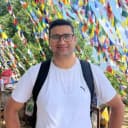
Mera Peak was the perfect challenge for me as an intermediate climber. The itinerary was well-paced, and the team took great care of us. The...
Climbing Mera Peak was a dream come true! The team at Himalayan Massif Trek was incredibly professional and supportive. Our guide was knowledgeable and ensured...
